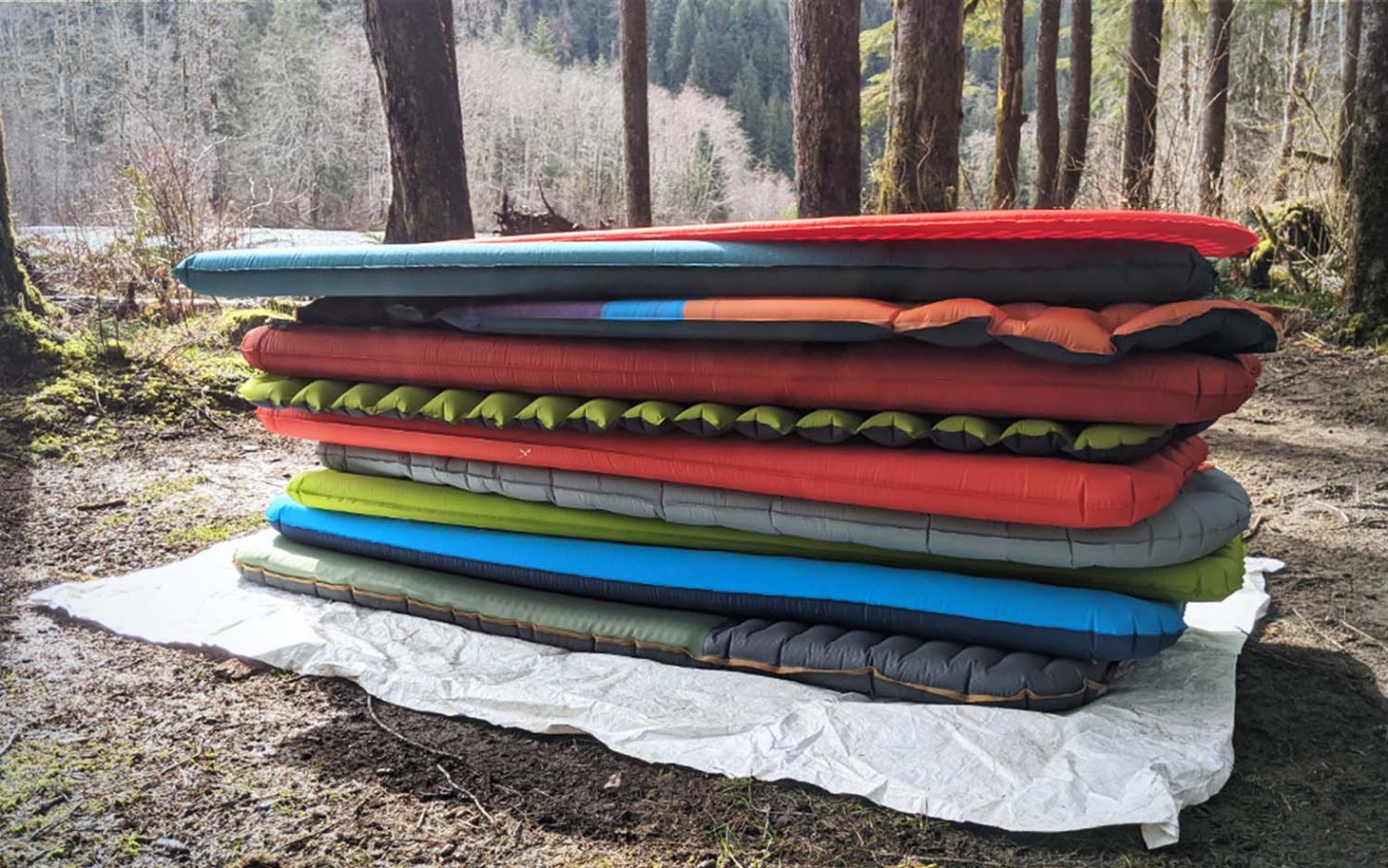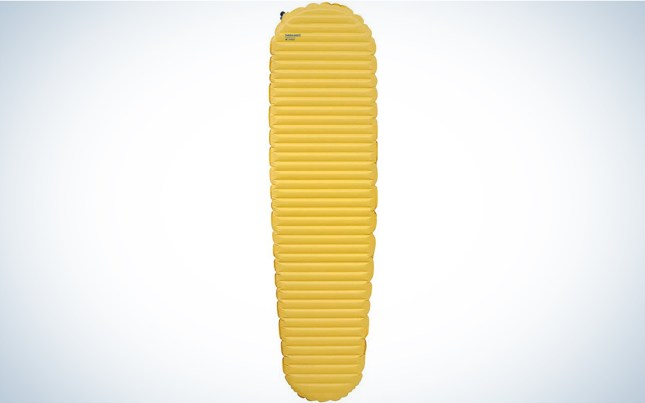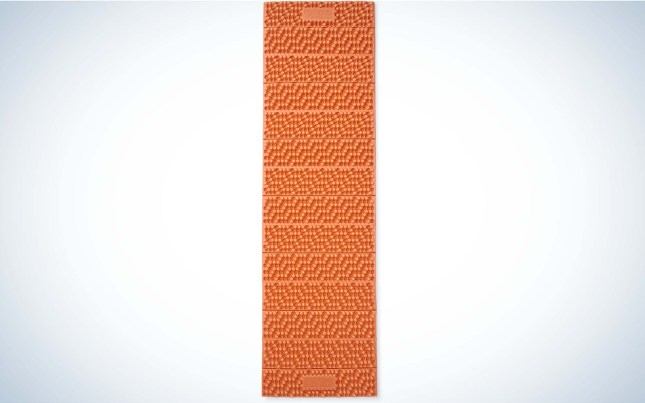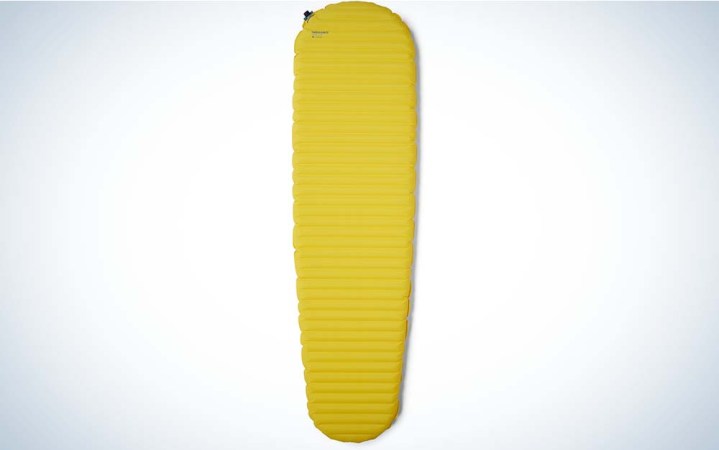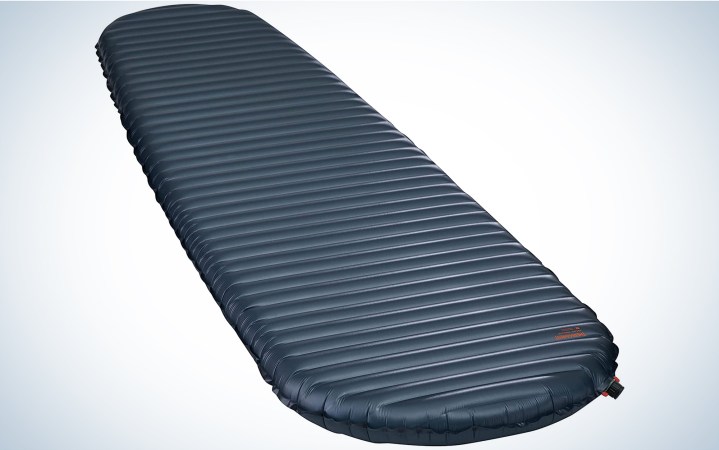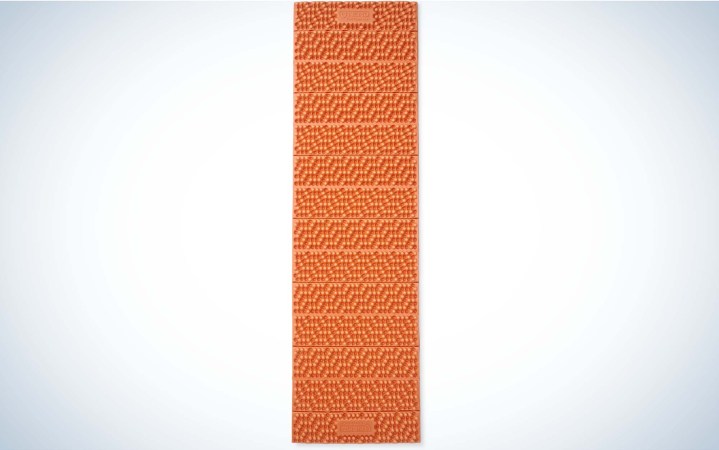We may earn revenue from the products available on this page and participate in affiliate programs. Learn More ›
It only takes one fitful night in the backcountry — shivering, hips bruised, cricked neck — to realize the importance of a great backpacking sleeping pad. But adding a quality pad also adds significant weight and cost to your kit, so it’s essential to get the right pad the first time. After testing dozens of different backpacking sleeping pads from seven different manufacturers, these are my top picks for the best backpacking sleeping pads for every adventure.
- Best Overall: Therm-a-Rest NeoAir Xlite NXT
- Best for Cold Weather: Nemo Tensor Extreme Weather
- Best Ultralight: Therm-a-Rest Uberlite
- Best Budget: Big Agnes Divide Insulated
- Best Closed-Cell Foam: Nemo Switchback
How I Tested and Evaluated the Best Backpacking Sleeping Pads
I’ve trekked thousands of miles and slept hundreds of nights in the backcountry. That experience forms the basis of how I tested and evaluated the best backpacking sleeping pads, with a focus on what is most important to backpackers: weight and comfort.
Weight is a familiar consideration for backpackers: all things being equal, you want the lightest gear possible to travel comfortably through the backcountry. But the comfort of a backpacking sleeping pad depends on both its ability to protect your body from the firmness of the ground, and from the cold of the ground. This latter consideration is often overlooked by even experienced backpackers, leading to unnecessarily cold nights in the backcountry. A backpacking sleeping pad’s insulation potential is measured in R value, with higher R values providing greater insulation. R value is tested by a third-party in accordance with ASTM F3340-22.
Read Next: What Is R Value: It’s Why Your Sleeping Bag Doesn’t Keep You Warm
In addition to the above criteria, I also assessed ease of inflation/deflation (both by blowing in the valve and using the provided pump sack), packed size, and price. Where possible, weight and thickness were checked against manufacturer specifications; as such, some measurements may vary from the manufacturer websites.
Associate Editor Ashley Thess tested closed-cell foam pads while camping and backpacking in Utah in warmer temperatures appropriate for their lower R value. They were primarily evaluated on comfort in a variety of sleeping positions.
Best Backpacking Sleeping Pads: Reviews & Recommendations
Best Overall: Therm-a-Rest NeoAir Xlite NXT
Key Features
- Size Range: S (20 inches x 66 inches) to L (25 inches x 77 inches)
- Weight: 13 ounces for a regular (11.5 ounces for a small)
- Height: 3 inches
- R Rating: 4.5
- Fabric: 30D ripstop HT nylon
Pros
- Comfortable enough to cushion hips on even rocky terrain
- Very lightweight compared to other pads with a similar R value
- Surprisingly durable for its fabric thickness
Cons
- Confusing valve, no included pump sack
The best backpacking sleeping pads deliver the comfort and warmth that backpackers need to head into the alpine while keeping the weight and packed size at an absolute minimum. And in that field the Therm-a-Rest NeoAir Xlite has long reigned supreme, weighing only 13 ounces while still delivering an R rating of 4.5. It’s the most popular backpacking sleeping pad among thru-hikers, and it’s what been in my backpack for years.
The latest iteration of the NeoAir Xlite — the NXT — finally fixed the longstanding noise issue that had kept this backpacking sleeping pad from being our best overall pick in the past. In my review of this best-in-class sleeping pad, I found that while it wasn’t perfectly silent, its crinkle level has been reduced to the point that all but the very lightest sleepers are unlikely to be disturbed.
I’ve successfully used the NeoAir Xlite NXT for hundreds of miles on multiple thru-hikes. It’s the perfect combination of lightweight and comfort, with an R rating that will see you through alpine adventures and shoulder-season excursions alike. In that time, the only mishap I’ve experienced with the NeoAir Xlite was when I inadvertently slept on top of an especially pointy rock (the 2.5-inch stack height ensured I didn’t even notice it was there), which resulted in a deflated mattress by morning. Fortunately, I was able to patch the pad with the repair kit the next day.
The only downside to the NeoAir Xlite NXT is the less-than-intuitive valve and a pump sack that takes about three times as long to use as other models out there. But these are small considerations next to the pros of this pad: It will keep you warm and comfortable on the chilliest nights and add a negligible amount of weight to your pack.
How It Compares
In weight to R value, the Nemo Tensor All-Season and the Big Agnes Zoom UL are running neck and neck with the Therm-a-Rest NeoAir Xlite NXT. In my experience, the lackluster (and heavy) pump sack that comes with the Zoom UL, makes this one a less appealing option, despite the lower price point. In our testing, this one also sprang a leak after a handful of uses, which is not typical among this class of backpacking sleeping pads. The Tensor All-Season represents a more direct trade-off: get some extra insulation for a little bit of extra weight. In my experience, the 4.5 R value of the NeoAir Xlite is plenty for most people in most backpacking scenarios including alpine weather and late spring, early fall shoulder season conditions. But if you know you run cold, you won’t regret carrying an extra ounce to get the extra R value.
For most backpackers, the lower R value and higher weight of the Sea to Summit Ether Light XT make this one a non-starter, although I do appreciate this brand’s integrated pump sack and stuff sack. Exped is closer to competing with this group, with a lower price point and competitive weight, but falls short on R value.
| Sleeping Pad | List Price | Weight | R Value | Available Lengths | Available Widths |
| Big Agnes Zoom UL | $180 | 14 oz | 4.3 | 72” to 78” | 20” to 25” |
| Exped Ultra 3R | $160 | 13 oz | 2.9 | 72” to 78” | 21” to 26”, 41” to 51” |
| Nemo Tensor All-Season | $200 | 14 oz | 5.4 | 72” to 76” | 20” to 25” |
| Sea to Summit Ether Light XT | $200 | 17.3 oz | 3.2 | 66” to 79” | 22” to 25” |
| Therm-a-Rest NeoAir Xlite NXT | $210 | 13 oz | 4.5 | 66” to 77” | 20” to 25” |
Best for Cold Weather: Nemo Tensor Extreme Conditions
Key Features
- Size Range: R (20 inches x 72 inches) to LW (25 inches x 76 inches)
- Weight: 17 ounces for a regular mummy
- Height: 3.5 inches
- R Rating: 8.5
- Fabric: 20D nylon on top; 40D nylon on the bottom
Pros
- Best warmth-to-weight ratio there is
- Comes with a handy velcro strap
- Larger size is a great fit for bigger individuals
Cons
- None whatsoever
When you’re sleeping out of doors in cold weather, you need protection from two things: the cold of the air and the cold of the ground. Sleeping bags, both down and synthetic, are aces at protecting you from the cold of the air. The cold of the ground, though? Not so much. That’s what your sleeping pad is going to do. The best cold weather sleeping pads are tested to determine their R value, which is a measurement of their ability to block (resist) cold temperatures from creeping through. The higher the R value, the more protection you’ll have. If the ground is going to be covered in snow or frozen, you want at least an R value of 7. The higher the better. I tested out the Nemo Tensor Extreme Conditions and if warmth and packability is your goal (it is), there is nothing better. It packs down to less than a Nalgene, it only weighs about a pound, and it’s easy to inflate.
How It Compares
Other top contenders for the best for cold-weather slot include backpacking sleeping pads from Exped, Sea to Summit, and Therm-a-Rest. I’ve tested the Therm-a-Rest NeoAir Xtherm out in field on numerous occasions, and have tested the lower R-value equivalents of the Exped Ultra 7R and the Sea to Summit Ether Light XT Extreme Insulated. In my experience, the Therm-a-Rest NeoAir Xtherm is an excellent choice if you’re willing to to take hit on R value to save a couple of ounces in your pack. It’s a pad I frequently recommend to women who are sleeping cold in the shoulder season or the alpine. In my experience, the vertical baffles of Exped’s pads are less comfortable than the honeycomb baffles featured on other pads on this list. The material used on this sleeping pad is also noticeably less thick (20D polyester) than the more common 40D or even 70D of the other pads listed here. Exped does make a best-in-class pump sack, however. The Sea to Summit Ether Light XT Extreme Insulated is both heavier and a lower R value than the others listed here, but still worth a look if you can find it on sale.
| Sleeping Pad | List Price | Weight | R Value | Available Lengths | Available Widths |
| Exped Ultra 7R | $240 | 18 oz | 7.1 | 72” to 78” | 21” to 26” |
| Nemo Tensor Extreme Conditions | $250 | 17 oz | 8.5 | 72” to 76” | 20” to 25” |
| Sea to Summit Ether Light XT Extreme Insulated | $230 | 25 oz | 6.2 | 72” to 79” | 22” to 25” |
| Therm-a-Rest NeoAir Xtherm | $240 | 15.5 oz | 7.3 | 72” to 77” | 20” to 25” |
Best Ultralight: Therm-a-Rest Uberlite
Best Ultralight
Therm-a-Rest Uberlite
Key Features
- Size Range: S (20 inches x 47 inches) to L (25 inches x 77 inches)
- Weight: 8.8 ounces for a regular (6 ounces for a small)
- Height: 2.5 inches
- R Rating: 2.3
- Fabric: 15D nylon
Pros
- Extremely lightweight
- Comfortable
Cons
- Expensive
- Lower R rating is not suitable for shoulder season or alpine adventures
- More fragile than heavier sleeping pads
This backpacking sleeping pad is so light and so tiny, you’ll barely notice it’s in your pack during the day. But at night, it’s just as comfortable as the standard Xlite. There are two catches here — the first is that this has about half the R rating of the Xlite, similar to top-performing closed-cell foam pads. It’s suitable for summer camping (and early fall if you run hot), but you’ll be compromising the performance of the rest of your sleep system if you take it into colder conditions than that.
The second is that this sleeping pad is fundamentally more fragile than the Xlite. Instead of a 30D ripstop nylon, it only uses 15D nylon for the shell. If you’re used to getting away with only a cursory kick of the largest rocks before throwing your sleeping pad on the ground, you’re going to need to take more care with this pad (some kind of groundsheet beneath it is a must).
How It Compares
In my opinion, if you’re looking to go UL you have to go hard, and that’s the NeoAir Uberlite. But if you’d like something a little more substantial than a 15D shell, the Exped Ultra 1R costs substantially less, has a 20D shell, and is still very lightweight, if not as ridiculously so as the UberLite. (It’s also available as a double-wide option.) The catch is that the R value is so low, it’s essentially non-existent: in terms of temperature you’re basically sleeping on the ground. The Nemo Tensor Ultralight gives you a little more ground protection than either of these two options, but at a higher weight.
| Sleeping Pad | List Price | Weight | R Value | Available Lengths | Available Widths |
| Exped Ultra 1R | $140 | 11 oz | 1.3 | 72” to 78” | 21” to 26”, 41” to 51” |
| Nemo Tensor Ultralight | $180 | 13 oz | 2.8 | 72” to 76” | 20” to 25” |
| Therm-a-Rest NeoAir Uberlite | $230 | 8.8 oz | 2.3 | 47” to 77” | 20” to 25” |
Best Budget: Big Agnes Divide Insulated
Key Features
- Size Range: S (20 inches x 66 inches) to XL (25 inches x 78 inches) and a double-wide (50 inches x 78 inches)
- Weight: 22 ounces
- Height: 3.5 inches
- R Rating: 4.0
- Fabric: 70D ripstop nylon
Pros
- Comparatively low price
- Thick enough for side sleepers to sleep comfortably
- High R value for the price point
- Durable shell material
Cons
- Wide baffles make for a bumpier sleeping surface
- Heavy compared to other top pads on this list
After you’ve shelled out major dollars for a backpack, a tent, and a sleeping bag, there isn’t always a lot leftover for a sleeping pad. But the Big Agnes Divide Insulated is an affordable option that is warm enough to take you up into the alpine and into the shoulder seasons while staying comfortable enough to ensure you’re actually glad to be out there.
I tested this sleeping pad’s predecessor, the Air Core Ultra, and found that the vertical baffles are substantially wider than others on the market. For the 20 inches x 72 inches size, the Big Agnes had six baffles, while the Exped Ultra 3R had eight. This meant that when I was resting on my back, I could feel the individual baffles underneath me. It’s not uncomfortable per se, but it is distracting. That said, side sleepers will find the thickness of this mattress quite cushy.
At 3.9 ounces, the pump sack for the Air Core Ultra was easily the heaviest I weighed (although props to Big Agnes for making it out of upcycled pad material) and took noticeably longer to use than the versions from Exped, Sea to Summit, Nemo, or UST.
How It Compares
Dollar for dollar it’s hard to find a backpacking sleeping pad that costs less than the Klymit Static V. And some people really like this pad’s unusual baffle design; I, however, am not one of them. Given that the low R value makes this one equivalent to sleeping directly on the ground, I’d recommend choosing a closed-cell foam sleeping pad instead. The Therm-a-Rest Venture and Exped Versa 2R are very competitive with the Big Agnes Divide Insulated on price point and weight, but don’t approach it’s insulation. Unless you are planning to only backpack in the dog days of summer, go with the Big Agnes.
| Sleeping Pad | List Price* | Weight* | R Value | Available Lengths | Available Widths |
| Big Agnes Divide Insulated | $120 | 22 oz | 4.0 | 66” to 78” | 20” to 25”, 50” |
| Exped Versa 2R | $110 | 21 oz | 2.4 | 72” | 21” |
| Klymit Static V | $65 | 18.7 oz | 1.3 | 72” to 78”, 74” | 23”, 47” |
| Therm-a-Rest Venture | $125 | 19 oz | 2.2 | 72” to 77” | 20” to 25” |
Best Closed Cell-Foam: NEMO Switchback
Best Overall Closed-Cell Foam Pad
NEMO Switchback
Key Features
- Size Range: S (20 x 51 inches) and R (20 x 72 inches)
- Weight: 14.5 ounces for a regular
- R Rating: 2
- Insulation: Low-emissivity film
Pros
- Comfortable
- Lightweight
- Insulated coating
- Packs down to 5 inches
Cons
- Not very durable
I have used the short version of this pad for eight months now, so I was excited to see how it measured up to its competitors. The hexagonal node pattern is part of what makes this pad the most comfortable in all sleeping positions. Instead of a traditional egg carton pattern, the nodes are more spread out, taking away the pokey feeling other pads have. This unique design is also what makes the Switchback pack down compactly and stay so warm. I recently slept like a baby in the low 40s using this pad alone. I supplement it with a backpacking pillow and add an inflatable pad for winter excursions.
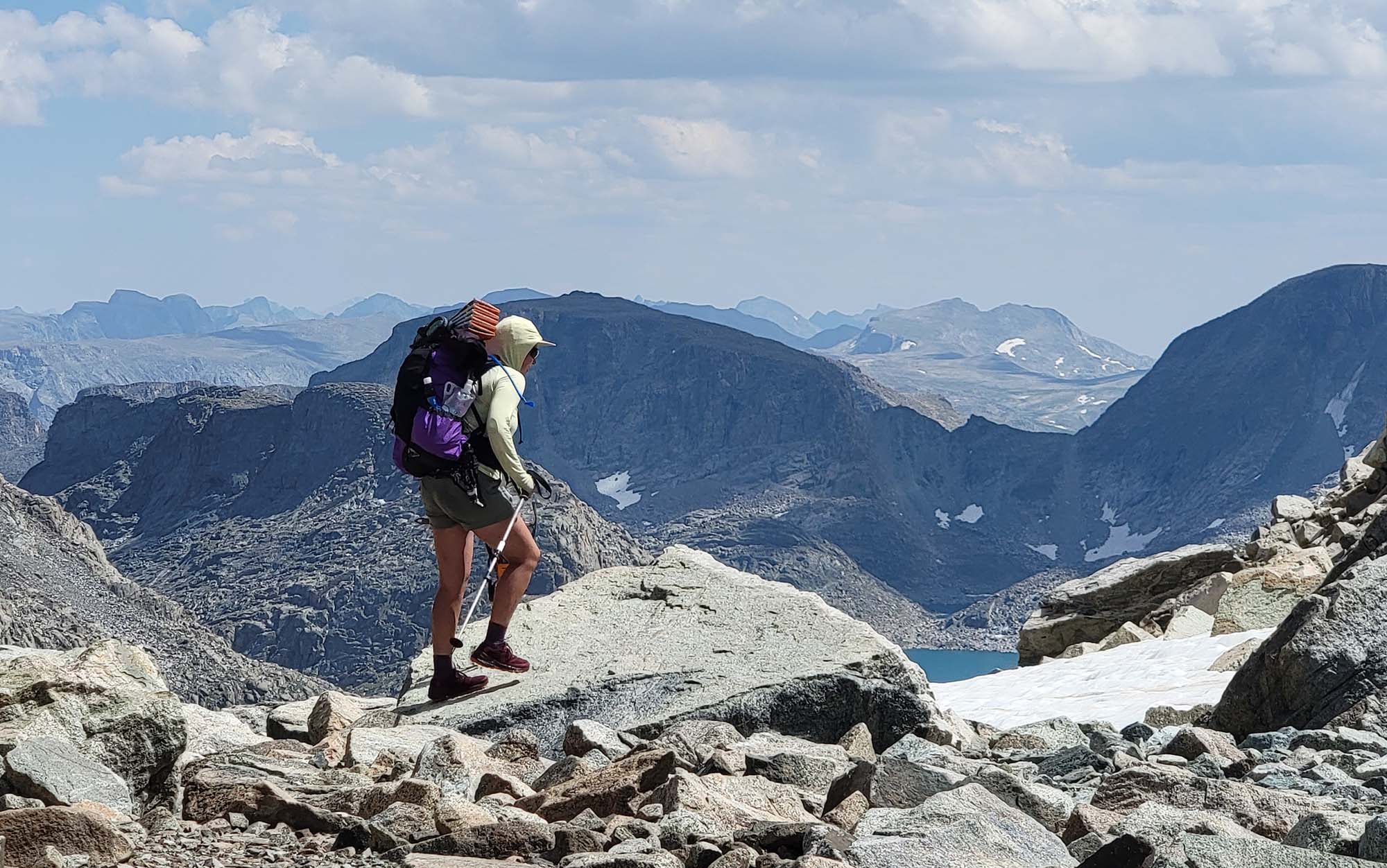
However, if you’re guilty of thrashing your gear (like I am), then this pad could be quick to show signs of wear. While the dual-density foam offers a cushy top layer and supportive bottom layer for improved comfort, that supple top layer can be easily shredded by branches and rocks. Unlike the Therm-a-Rest Z Lite, however, the insulated coating is protected by the accordion fold. This pad is meant to be slept on silver side down, because the orange foam layer acts as a heat trap, catching the warmth of your body that’s being reflected back to you via the low-emissivity film. —Ashley Thess
How It Compares
Running neck and neck with the Nemo Switch is the Therm-a-Rest Z Lite SOL. Both are a similar weight and a similar R value, but the latter is thicker when packed up and folds up in a manner that exposes the reflective ThermaCapture coating. Ashley noted that puts it at risk of being thrashed by abrasive sticks and rocks if you’re not careful. She also found that while it was less comfortable for stomach sleepers, a real winner for side sleepers is the egg-carton style of the Exped FlexMat Plus. While Ashley tested the Exped FlexMat as part of her test of the best closed-cell foam pads, but ultimately felt that the thin profile made it feel like she was sleeping on the ground.
| Sleeping Pad | List Price | Weight* | R Value | Available Lengths | Available Widths |
| Exped FlexMat Plus | $60 | 18 oz | 2.2 | 51” to 72” | 21” |
| Nemo Switchback | $55 | 14.5 oz | 2.0 | 51” to 72” | 20” |
| Therm-a-Rest Z Lite SOL | $58 | 14 oz | 2.0 | 51” to 72” | 20” |
Why I’m Not Recommending Self-Inflating Backpacking Sleeping Pads
A style of backpacking sleeping pad that continues to be popular despite better options on the market are self-inflating pads. These pads incorporate foam into their design and structure their baffles in such a way that you can, theoretically, open up the valve and they’ll inflate on their own. The argument in favor of these sleeping pads is that, in the event that your pad develops a hole, the foam means you’ll have at least some protection underneath you. People also like the idea of self-inflating, especially in contrast to laboriously blowing up a sleeping pad themselves. Finally, adding foam to a backpacking sleeping pad seems like it would make it more comfortable.
Unlike the best air mattresses for camping, self-inflating backpacking sleeping pads are not more comfortable than air-only pads. This is because they don’t provide enough height off the ground, typically two inches or less of height. In my experience, you can feel the hardness of the ground through the foam as soon as you lay on it.
Most people find that, in the field, self-inflating sleeping pads don’t inflate as quickly as they expect, or at all. This is because most people store their sleeping pads packed away, which inhibits the foam’s ability to take on air quickly. Typically, people will report that it will inflate a bit, maybe halfway, over the course of an hour or two, and then they have to finish inflating it the rest of the way manually. Where the self-inflating part usually comes into play is when you pack it away again, as these pads resist having the air squeezed out of them. That’s why their stuff sacks have compression straps on them, unlike typically backpacking sleeping pads.
Modern backpacking sleeping pads also typically come with a pump sack, which massively reduces the time and effort required to manually inflate an air-only pad.
If you’re still tempted to purchase a self-inflating sleeping pad, I would recommend opting for pairing a low-cost closed-cell foam pad with a typical air-only backpacking sleeping pad, instead. As you get more comfortable with your setup, you’ll likely eventually discard one in favor of the other.
How to Choose a Backpacking Sleeping Pad
Your Sleep System
Your backpacking sleeping pad is the foundation of your sleep system, so it’s important to consider how it integrates with either the best sleeping bag or the best backpacking quilt. Keep in mind that the temperature ratings of sleeping bags assume you are using a sleeping pad with a minimum R rating of 4.8.
Noise
While most inflatable backpacking sleeping pads aren’t exactly silent, they are quiet enough. In my experience, the backpacking sleeping pads with exceptionally high warmth and a low weight typically have a bit of a crinkle to them, due to the metallic film in the insulation. While the Therm-a-Rest NeoAir series used to have a reputation for being exceptionally loud, they were able to resolve this issue in their release of the NXT update.
Thickness
Too-thin backpacking sleeping pads can become uncomfortable over the course of the night, especially for individuals who are sensitive to feeling the hardness of the ground against their backs or hips. In my experience, thickness is more important than the inclusion of foam in an inflatable sleeping pad (a major reason why I don’t recommend so-called self inflating mattresses for backpacking).
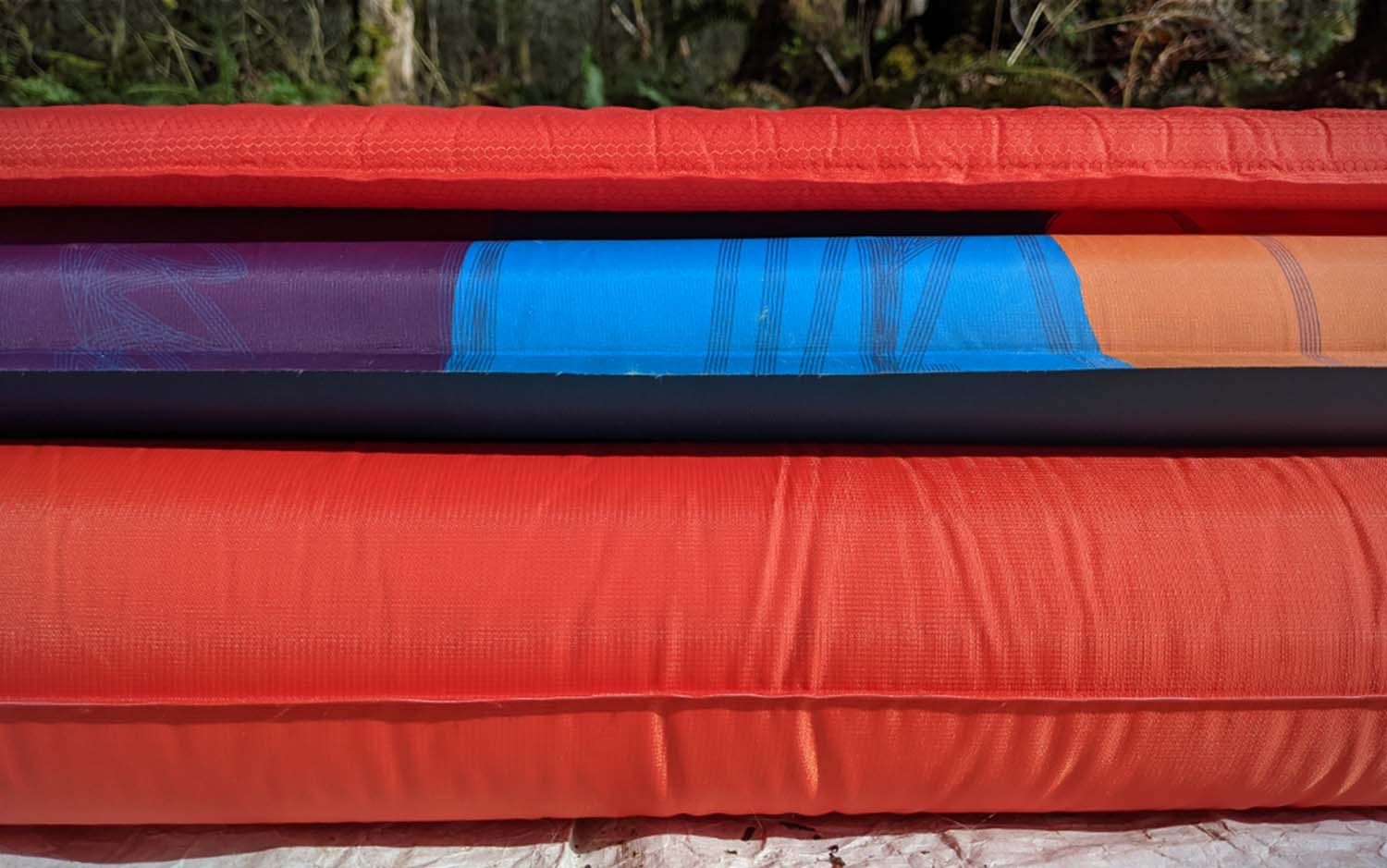
Comfort
This is a subjective measurement, more so as there isn’t any backpacking sleeping pad which is truly comfortable — don’t expect to be as comfortable as you are at home. Far and away the most important factor impacting your comfort is if it’s thick enough to protect you from the hardness of the ground. Next up is the inclusion of foam (although this typically comes with a major weight penalty). Finally, there is the baffle design. In my personal experience, the waffle design of backpacking sleeping pads like the Sea to Summit Ether Light XT Insulated Air Sleeping Mat are the most comfortable, but others prefer the horizontal baffle style of the Therm-a-Rest NeoAir or the the more unusual design of the Klymit Static V2. The only way to determine what your preference is is to try a few different types out camping.
Things to Consider Before Buying the Best Backpacking Sleeping Pad
Inflatable vs. Closed-Cell Foam
The choice between an inflatable sleeping pad versus closed-cell foam is one of performance versus reliability. Inflatable pads are warmer, lighter, fit easily into your pack, and are almost always more comfortable. However, closed-cell foam pads never unexpectedly deflate overnight, don’t take up room inside your pack, and double as a butt pad for breaks. (Learn more from our guide to inflatable vs. cell-foam sleeping pads.)
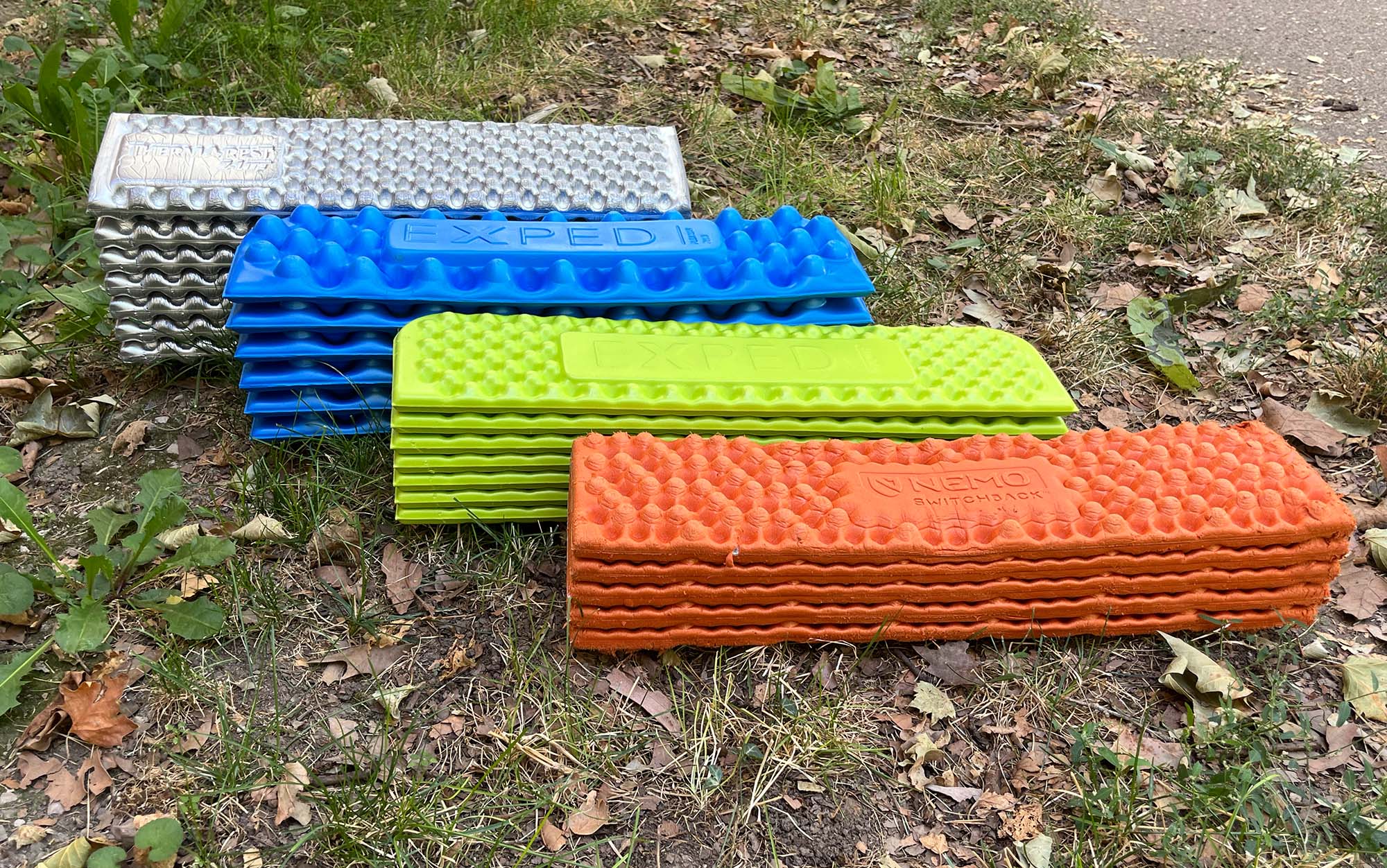
Material
The exterior of inflatable backpacking sleeping pads is usually constructed from either polyester or nylon at varying thicknesses, which is measured in denier (D). Most backpacking sleeping pads are between 20D, the thinnest material, typically used for ultralight pads, to 75D in thickness, which approaches the thickness typically seen on car camping pads. Nylon is generally a stronger material than polyester, but laminates (which can make a pad more airtight) apply better to polyester than to nylon.
Closed-cell foam pads are obviously made of closed-cell foam which is an insulating and water resistant material that can keep hikers happy on warm nights and supplement an inflatable pad in the cold. The best backpacking sleeping pads made of closed-cell foam sometimes include a metallic lining for an increased R rating.
Weight
Most of the best backpacking sleeping pads weigh between 1 and 2 pounds, with the heavier end of the spectrum providing greater comfort and the lighter end of the spectrum typically running quite narrow. It’s hard to put a value on a great night of sleep when you’re facing ten plus miles of hiking in the morning, so we recommend erring on the side of caution. One way to save weight, for some backpackers, is to choose a short sleeping pad, and then tuck your backpack under your feet at night. This way, your hips and shoulders get the benefit for a fraction of the ounces.
Size
There are two sizes that you should be concerned with — the size of the pad packed into your backpack or strapped to the outside, and the size of the pad when it’s inflated. Most pads today come in sizes ranging from short to tall, regular to wide; however, in our experience even the “wide” size — typically 25 inches — is not all that wide. Two exceptions to this are the Klymit, which has a wide size of 29 inches, and the Big Agnes Q Core Deluxe, which goes out to 30 inches. Couples looking to share a pad can look for a double-wide pad or one of the best camping mattresses for couples.
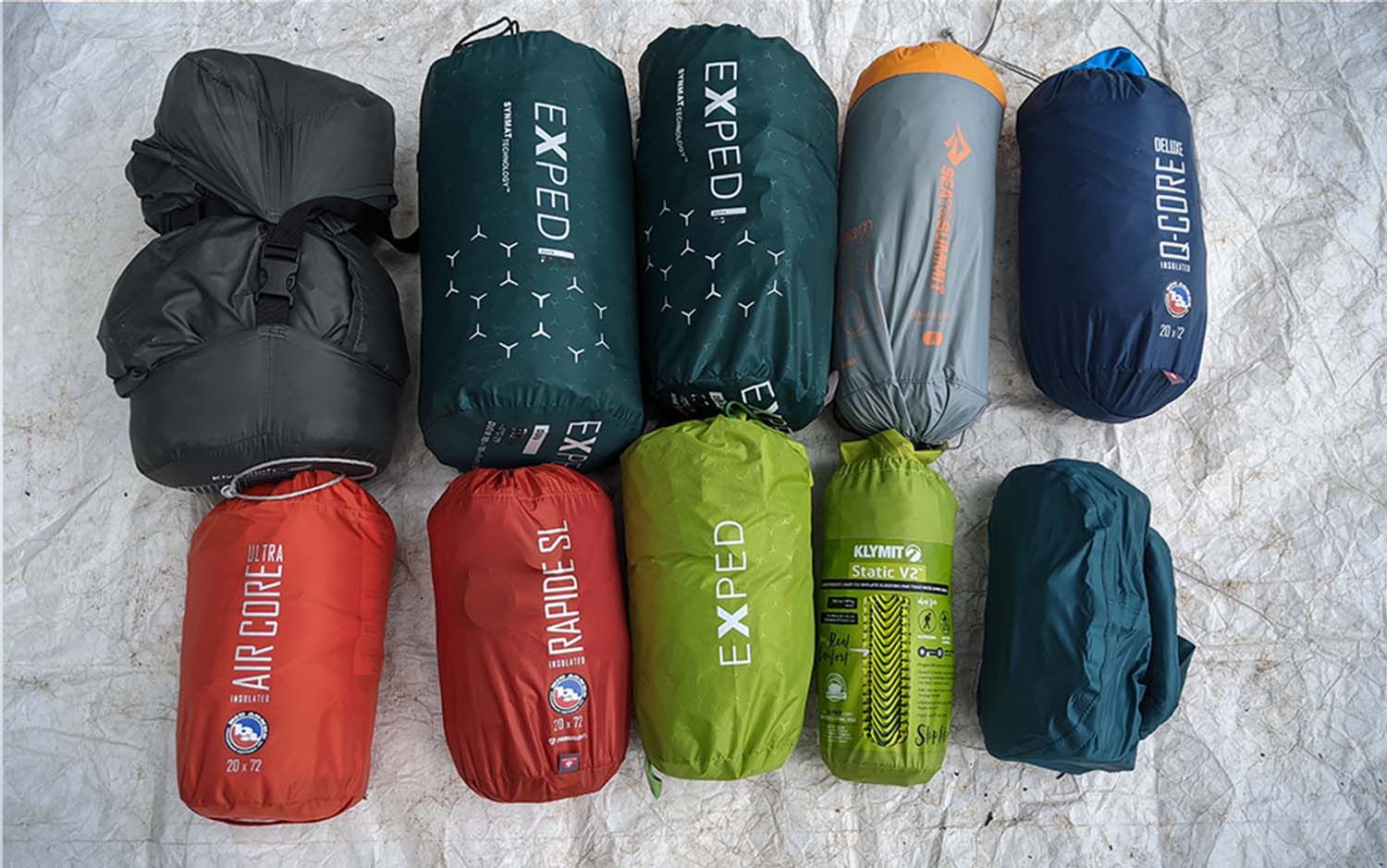
Shape
Most sleeping pads are one of two shapes: rectangular or mummy. The idea behind the mummy-shaped pads is simple — your body isn’t rectangular, so why should your pad be? This design also shaves off a few ounces. But plenty of backpackers, especially side sleepers, find that the mummy-shaped pads are easier to roll off of, and prefer a rectangular pad for that reason.
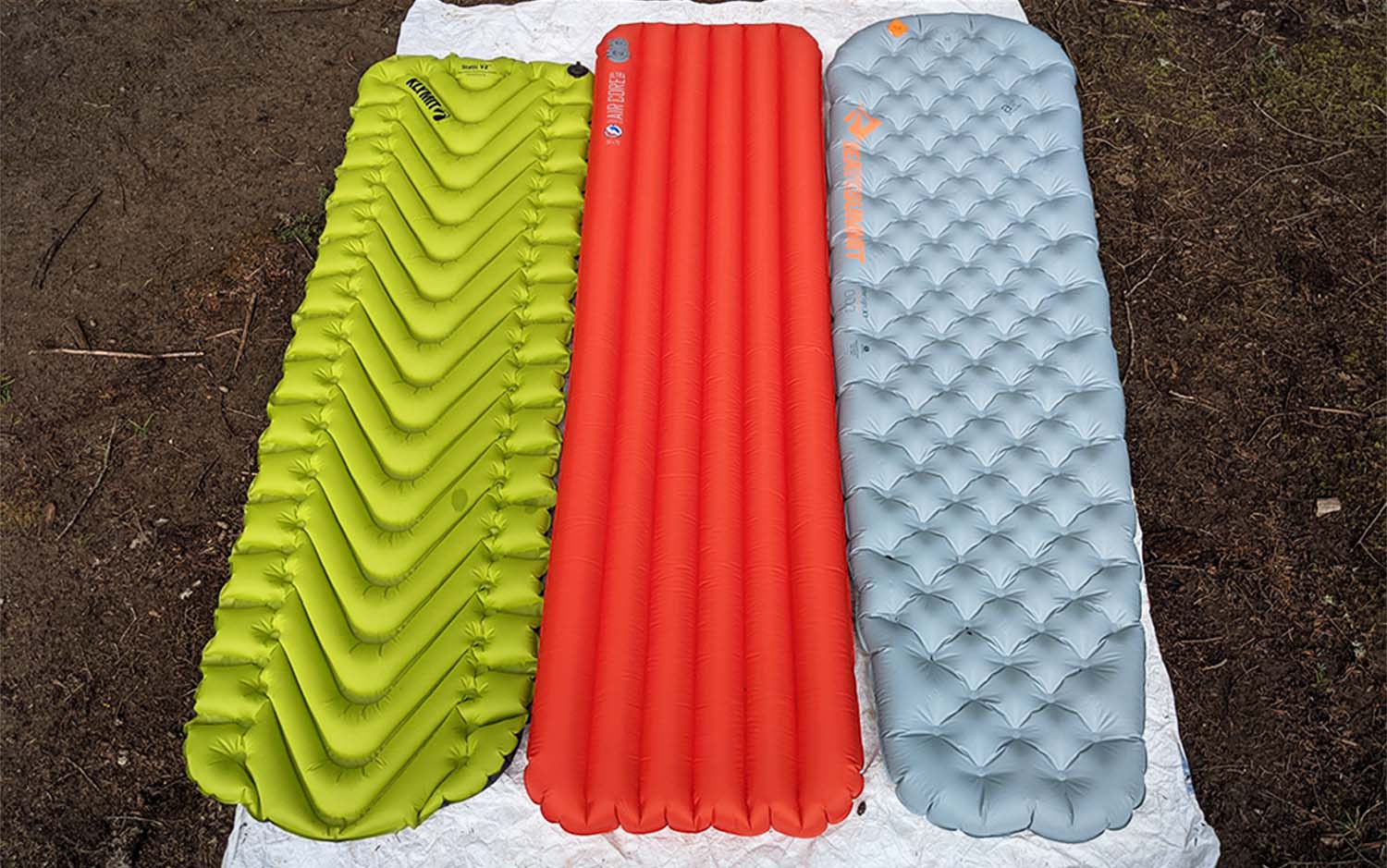
R Rating
As anyone who has been backpacking during a shoulder season knows, the cold from the ground will suck out your body heat faster than cold air, leaving you shivering inside of your 20-degree bag. The R value measures how well the pad insulates (or “resists,” hence the R) the cold, with 1 being the lowest rating (suitable for lowland backpacking at the height of summer) all the way up to 10 (typically only needed in extreme conditions). Sleeping pad manufacturers once conducted their own testing (or in some cases simply guessed), but as of 2020 R ratings are standardized by the American Society for Testing and Materials (ASTM).
FAQs
A quality backpacking sleeping pad typically runs $100 to $200, with those suitable for winter camping upwards of $250. Closed cell-foam sleeping pads are closer to $50 with the budget pick only costing $35.
If you’re young and only planning to summer backpack for a night or two in a forest with a cushioned, pine-needle floor (I’m looking at you, Oregon), then maybe — maybe — you can get away without a sleeping pad. But we wouldn’t recommend it. For shoulder season or winter travel, or any travel at altitude, the warmth provided by a backpacking sleeping pad is essential, not only to your comfort, but also to your safety.
Like with sleeping bags, the question of what R value you’ll need for your camping sleeping pad depends on your natural core temperature. For summer adventures through the foothills, you can disregard this number, as almost any R value will do. For shoulder season backpacking, or if you plan to spend significant time in the alpine, an R value of 3 to 5 is best. Anyone planning on a backpacking trip where subzero temperatures are a possibility needs to have a pad rated to at least 6. Adjust as needed if you sleep cold or run hot. Backpackers who use quilts, as opposed to traditional sleeping bags, should choose a pad with an R value that is slightly higher than they think they need.
No, self inflating sleeping pads are not a good choice for backpacking. There are three main reasons to avoid them. First, the hassle and muscle power required to force the pad back into its stuff sack the next morning outweighs the convenience. Next, these pads are typically much thinner for the same weight, which means you are more likely to feel the hard ground underneath your back or hips. Finally, the pump sacks provided by (or even integrated into) a number of the above picks completely eliminates the light-headedness that you might remember from blowing up sleeping pads in the past. Only a few light breaths (less than you would use to blow out a candle) are needed to inflate these sacks.
Look for sleeping pads that are a minimum of 2.5 inches thick to ensure that you’re protected from the hardness of the ground. After that, it’s not especially important how thick a sleeping pad is, although some individuals report that they struggle with slipping off of those that are 4 inches or higher.
Yes, stacking sleeping pads (usually done with a closed-cell foam and an inflatable air mattress) results in an increased R value. While a good rule of thumb is that you can add two R values together, it’s worth keeping in mind that this has not been assessed by ASTM.
Backpacking sleeping pads can last for years, or even decades, depending on how you care for them — most top manufacturers offer limited lifetime warranties as a result. The most important step is to always take care to ensure that there are no sharp objects on the ground below your backpacking sleeping pad when setting up for the night. (Although if you do end up with a hole in the pad, they are easy enough to repair it, as long as it isn’t along one of the seams.) At home, give your backpacking sleeping pad some time to air dry after each trip before storing it away for the season to help reduce the potential of mold accumulation.
You do not need to clean or wash your backpacking sleeping pad, but you may want to if it gets excessively dirty, greasy, or sandy. The first step is to close the valve — you do not want water sneaking into your backpacking sleeping pad as that can harm the interior insulation and/or collect mold. Next, grab some warm water and hand wash the exterior of the sleeping pad in a bathtub or similar. Your last step is dry off the sleeping pad — I like to hang it over a shower rod or off the back of a chair.
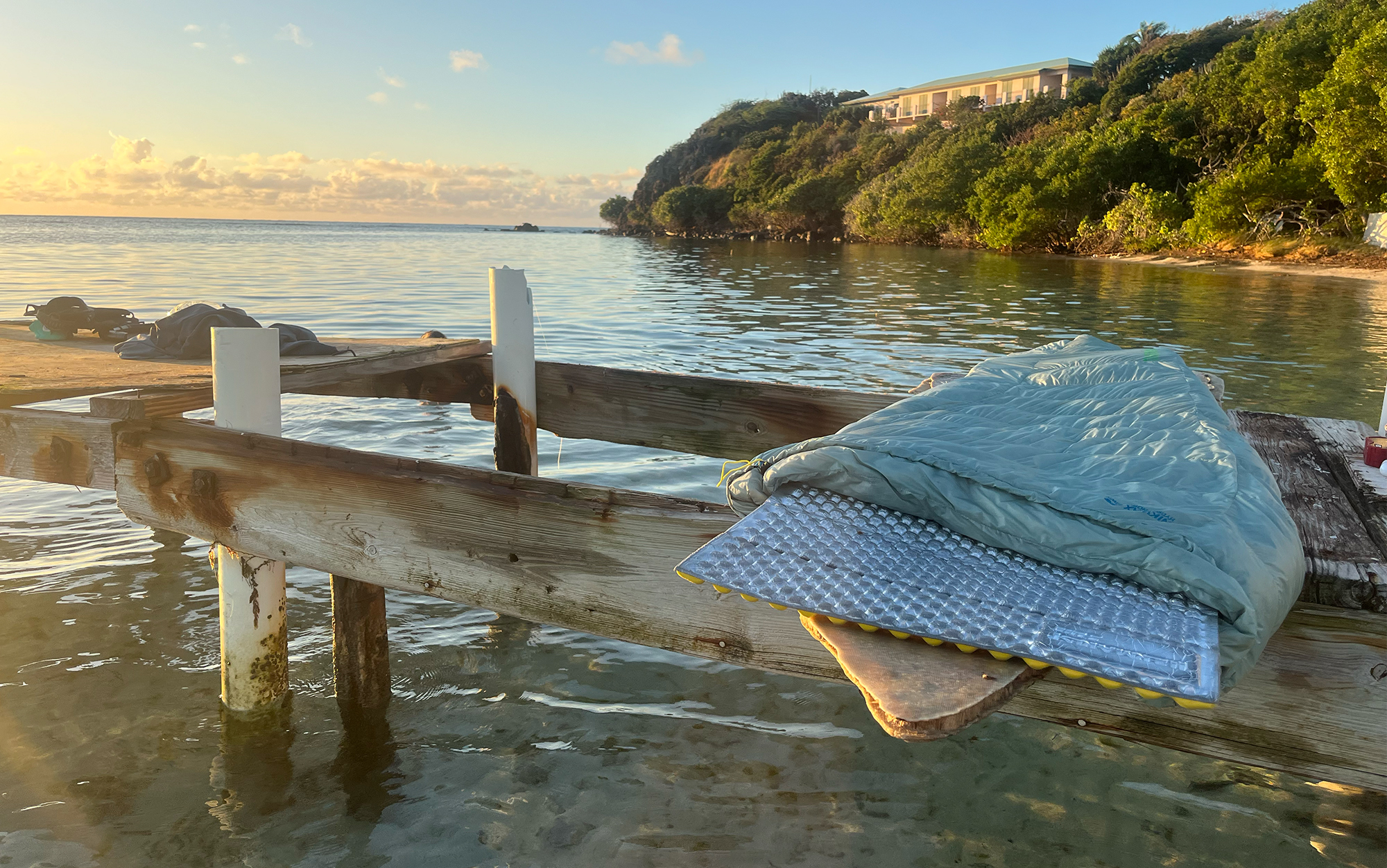
Final Thoughts on the Best Backpacking Sleeping Pads
Though not considered one of the “Big 3,” choosing the best backpacking sleeping pad for your sleep style and the temperatures you plan to trek out into is essential for avoiding the dreaded Type III fun. I sometimes skimped on pads when I was younger. But with more experience, I learned that a good sleeping pad makes it a lot easier to get a good night’s sleep, and that in turn makes the next day’s adventure all the more fun. I recommend thinking about your sleeping pad, sleeping bag or quilt, and, ideally, a pillow, as a complete system and budget your funds and ounces accordingly.
